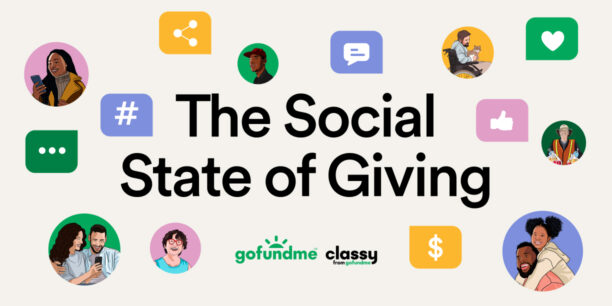How to Prevent Burnout at Your Nonprofit, From the Experts

To prevent burnout from taking over your nonprofit’s culture, passion, and productivity, you have to understand it. It’s important to know what causes burnout, the signs to look for in individual employees, and the responsibility of leaders to set an example.
Fifty-one percent of Americans reported mental health challenges at work since COVID-19 began, and 30% are fearful to report their mental health struggles to their employer.
May is Mental Health Awareness Month, but mental health in the nonprofit workplace is a topic that calls for an honest conversation all year long. That’s especially true coming off of a year defined by a global pandemic, social justice movements, and a tense presidential election.
We’re bringing that honest conversation right to you with some new voices with a passion for nonprofit culture and employee wellness.
MEET KRISTA WILBUR, CASE MANAGER AND PROGRAM EVENTS COORDINATOR AT AUSTIN ANGELS
 Krista joined the Austin Angels staff in 2018 without hesitation. She knew the job aligned her life experience, education, and passion to learn more about trauma, grit, grief, and resilience. Krista prides herself on helping others discover their resilience and use it to achieve their goals.
Krista joined the Austin Angels staff in 2018 without hesitation. She knew the job aligned her life experience, education, and passion to learn more about trauma, grit, grief, and resilience. Krista prides herself on helping others discover their resilience and use it to achieve their goals.
MEET LISA THOMPSON AND LIBBY RAPIN, FOUNDERS OF BLUWAVE WELLBEING
 Lisa and Libby have a collective 20 years of experience working with teams and individuals to improve their wellbeing, employee engagement, and workplace culture. Libby serves on the executive board for The Rock Center for Youth Development. She also sits on the Stigma and Working Adult committees for the Great Lakes Bay Mental Health partnership. Lisa is a leader on the MiHIA Thrive ACE’s initiative steering team and has worked with nonprofit organizations such as the American Cancer Society.
Lisa and Libby have a collective 20 years of experience working with teams and individuals to improve their wellbeing, employee engagement, and workplace culture. Libby serves on the executive board for The Rock Center for Youth Development. She also sits on the Stigma and Working Adult committees for the Great Lakes Bay Mental Health partnership. Lisa is a leader on the MiHIA Thrive ACE’s initiative steering team and has worked with nonprofit organizations such as the American Cancer Society.
Read the full interview with our experts to get answers to questions nonprofit leaders may ask about employee burnout, such as:
- How has COVID-19 impacted employee burnout and individual stress management?
- How do you recognize burnt-out employees and what happens if you ignore burnout?
- How do you recover from burnout with effective wellness habits for nonprofits?
- How do you build a culture of resilience with mental health resources for nonprofits?
Expert Advice to Prevent Burnout at Your Nonprofit
Q: HAVE YOU SEEN EMPLOYEE BURNOUT RISE DURING COVID-19 IN THE NONPROFIT SECTOR?

A: Definitely. Even before the COVID-19 pandemic, I watched as nonprofit employees gave up work to find something they felt was more manageable. COVID-19 has only exacerbated burnout as nonprofit employees faced greater needs than ever before. Compassion fatigue is real.

A: With many nonprofit leaders holding multiple hats and roles in their organizations, we constantly hear that they are exhausted. The pandemic caused additional burnout and stress as nonprofits had to pivot with less resources and rising cash flow issues.
Your Takeaway: You’re not alone if your nonprofit is experiencing burnout. The pandemic heightened underlying stressors across the sector, and in our personal lives as remote work continues.
Q: WHAT IS THE BIGGEST SHIFT YOU’VE SEEN WHEN IT COMES TO INDIVIDUAL STRESS MANAGEMENT AS A RESULT OF THE PANDEMIC?
A: Before the pandemic, stress management was a matter of employees taking care of themselves. The onus was on the individual to ask for what they needed and not so much on the organization.
There still is a personal responsibility today but I see successful companies stepping up. Employees now have more access to stress management resources and empowerment to seek the support they need on an individual level.

A: Individuals are exhausted, so they’re learning the importance of prioritizing their wellbeing and becoming more curious on how to do that. The mental health of employees is now on the radar of leaders. Companies are bringing the conversation about wellbeing to the executive table outside of just physical health.
Your Takeaway: Nonprofit leaders are offering more support for their employees’ mental wellbeing and stress management, which has a direct impact on their organization’s health.
Q: HOW DO NONPROFITS RECOGNIZE COMMON SIGNS IN EMPLOYEES TO PREVENT BURNOUT?

A: From the lens of working inside a nonprofit organization, my team is very vocal about when we begin to experience burnout. We can see burnout in one another based on simple things.
We specifically look for frequent discussion of feeling tired, not meeting deadlines, taking more sick leave, and negativity in our teammates. These are all key signs that a team is burning out and needs some support to get back on track.

A: We see very similar signs when we work with organizations. The most common signs of employee burnout we’ve seen are:
- Brain fog that causes forgetfulness of something a person has done before or randomly forgetting to complete tasks
- Difficulty concentrating and completing tasks with lack of motivation to get started
- Exhaustion, lower moods, anxiety, or depression
- Irritability that causes reactive behavior towards colleagues and customers
- Sudden cynical attitude about the job, company, or working conditions
- Frequent sicknesses such as headaches and stomachaches
- Excessive absenteeism and loss of purpose
Your Takeaway: What looks like a bad day to an outsider can really be a critical sign of burnout in an employee. Know what to look for and track how often bad days or moments occur to prevent burnout before it escalates.
Q: WHAT HAPPENS IF YOU IGNORE BURNOUT IN YOUR NONPROFIT ORGANIZATION?

A: For my organization, ultimately the families we serve will suffer. The work we need to do can’t get done if burnout is taking over and those impacted in the foster care system feel that. Resentment can breed in silence and become explosive if burnout goes unnoticed for too long.

A: If people aren’t well, their quality of work diminishes. You can argue that a burnt-out employee may be less productive and more likely to make mistakes. If your people are burnt out, your organization is burnt out, and that directly impacts your morale, culture, and ability to serve your communities.
Your Takeaway: Don’t allow burnout to overcome your nonprofit’s culture without a plan to prevent it. When burnout is present your employees suffer, but more importantly your mission suffers.
Q: WHAT WOULD YOU RECOMMEND AN EMPLOYEE DO TO RECOVER FROM BURNOUT?

A: My top recommendation is to communicate very early on. Ask for help when it’s appropriate with clear language. You could say, “That project sounds great, but my calendar is full and I don’t have the ability to commit to that right now.” It’s important to set boundaries and make sure your communication is being respected.
The key to balance is knowing there are moments in your professional career when you’ll give a bit more, and knowing when those moments are happening too often.

A: We would recommend self-care as a top priority. Take a staycation or dedicate 30 minutes to a nourishing morning routine (e.g., meditation, movement, breathwork, journaling). Make time to meet with a friend or loved one and talk to your manager. Give yourself a break by simply committing to logging off and shutting the computer at the same time every day.
If it seems challenging to find a moment for yourself, go inward and explore what may be preventing you from the self-care you need. Come back to the “why” or purpose motivating you to pursue mental wellbeing and allow that to guide you to take action.
Your Takeaway: Employees need a work environment that encourages open communication about mental health awareness and opportunities for self-care as they experience feelings of burnout.
Q: WHAT ADVICE WOULD YOU GIVE TO NONPROFITS TO PREVENT BURNOUT FROM SPREADING?

A: Introduce moments of honest conversation for your employees. It can be uncomfortable for individuals to advocate for themselves at work but nonprofits have the opportunity to ease that. By doing so, we can create meaningful relationships and healthier ways to cope with feelings of burnout.

A: We would agree with that, and add to it that it’s essential to get to the root cause to understand why employees are burnt out when you talk with them. You’ll want to understand if burnout is driven by personal demands, work demands, or both. From there, you can determine what projects can be shifted around.
To take it a step further, bring some fun into the workplace with an employee-driven break activity that happens at the same time each day. It’s something small like that that can lighten the stress at work. You may even consider bringing in an external partner to discuss wellbeing techniques.
Your Takeaway: Your culture will determine how early and often you find employee burnout in time to take action. An open communication style and proactive stress release initiatives make a big difference.
Q: WHAT WELLNESS HABITS ARE MOST EFFECTIVE FOR NONPROFIT ORGANIZATIONS TO PREVENT BURNOUT?
A: Provide people with a space to build physical and mental health. The nonprofit I work for has a weekly self-care call scheduled for case managers who interact with families that go through the hardest situations.
It’s challenging to hear their stories but knowing that we have a safe space to talk, cry, laugh, and connect with one another keeps us encouraged. There are also ways to promote mental health awareness by physically burning off steam.
My organization recently went ziplining together and it’s common to see our case managers walking every day, spending time outside, and participating in yoga. There’s room to be creative about how you can check in with employees to normalize wellness habits as a part of your nonprofit’s culture.

A: Exactly, leaders have to encourage employees to build wellbeing habits into each and every day with the right training and resources. You could bring in speakers to discuss wellness habits, provide online training, or make recommendations on what’s available in their local communities.
Be sure to check in on your staff and ask how individuals are doing outside of just work. Educate managers on how to prevent burnout by fostering positive employee experiences, setting clear expectations, communicating effectively, and removing barriers to support.
Your Takeaway: Recognize, reward, and encourage positive wellness habits to shift your nonprofit’s culture in a positive direction.
Q: WHAT IS ONE COMMON MYTH YOU’D LIKE TO BUST ABOUT BURNOUT?
A: It’s too often that we associate feelings of burnout with being weak. Nonprofit work is challenging, and a higher output is a normal expectation for a smaller salary.
Even outside of work, it’s extremely normal to get burnt out in a world that wants us to constantly be on the go. It’s exhausting, but experiencing burnout is not laziness or weakness.

A: We wholeheartedly agree and thought of the exact same myth. You are not weak if you feel burnt out. It is not your fault if you feel burnt out. There is no shame in feeling burnt out.
Seek help and openly admit where you’re at to give permission to others to do the same. It is okay to not always have a “can-do” attitude if your plate is already overflowing. The “cannot-do” attitude can mean that you are prioritizing your work to be more effective to generate results.
Your Takeaway: It’s time to reframe burnout as the wisdom to self-reflect and respond to our body’s natural signal for more rest and recovery.
Q: HOW CAN NONPROFITS BUILD A CULTURE OF RESILIENCE THAT IMPACTS THEIR ENTIRE ORGANIZATION TO PROACTIVELY ADDRESS AND PREVENT STAFF BURNOUT?
A: The research tells us that relationships help develop resilience. Talk about the hard things and normalize tough conversations to create a culture that is shame-free when it comes to burnout, starting with a leadership model of healthy self-care.
Be mindful not to put the concept of overworking on a pedestal. Resilience isn’t the absence of adversity; it’s the ability to come back from it.

A: Another key component to build strong relationships of resilience is to develop your leaders. A strong culture comes from the top when leaders promote open communication and regular check-ins.
Your Takeaway: Lead by example to show employees that your culture supports their wellbeing and supports them every step of the way.
Q: IN YOUR OPINION, DO YOU THINK BURNOUT IS LIKELY TO DECLINE OR RISE IN THE COMING YEARS?
A: Working until you break has been glamorized for a long time but the pendulum is swinging back. Over the next 5 to 10 years, I see people becoming more aware of burnout and that education in itself will prompt a slow decline. In some ways, the pandemic made things harder but it also showed us how productive we can be while still prioritizing rest.

A: One of the beautiful outcomes of the pandemic is that people are waking up to the importance of caring for their wellbeing and understanding more about how that’s done. The more people that awaken to this “new way of being,” the less burnout we should see over time.
Your Takeaway: While there’s no magic cure to prevent burnout, taking the right steps to understand it and educate yourself and your employees will move the needle forward toward a burnout-proof culture.
Daily Practices to Prevent Employee Burnout
OUR EXPERTS OFFER TANGIBLE TIPS TO HELP YOU STOP THE CYCLE OF BURNOUT RIGHT AWAY FOR YOUR NONPROFIT:
- Introduce flexible schedules: Give leeway to let employees create their own schedules whenever possible. Burnout can happen when you’re trying to force yourself into a schedule that doesn’t work for you, so this simple switch can impact a lot of flexibility in someone’s life.
- Normalize balance: Some companies value employees who check their email in the evenings and on weekends. As a leader, you can create the standard for when employees are expected to answer right away and when it’s more productive to embrace those moments to recharge. That off-time is how employees come back each day ready to tackle the big challenges of nonprofit life.
- Invest in your people: Provide training to invest in employee wellbeing, not just a day off or a pizza party. It’s about truly finding the right resources and training to build a strong culture.
- Define roles: Focus on clearly defining roles, which will go a long way to make sure no employee is spread too thin.
- Establish regular check-ins: When an employee expresses frustration or concern, address it immediately and make sure they know you will take appropriate action.
- Lead by example: Show employees you mean what you say about self-care by demonstrating it yourself. Openly discuss how workloads are impacting everyone and when it’s best to rest and reset instead of working through a situation that can lead to long-term burnout.
Mental Health Awareness Resources for Nonprofits
We’ve put together a list of organizations that support conversations around Mental Health Awareness Month and every other day of the year. Use this list to encourage wellbeing at an individual level and for employees at your nonprofit organization.
- Notice.Talk.Act.® at Work Employer Mental Health E-Learning
- Devereux Adult Resilience Survey (DARS)
- Devereux Resilient Leadership Survey (DERLS)
- Headspace for Nonprofits
- Peers for Progress National Peer Support Groups
- Safe Call Now 24-Hour Hotline
- Moodfit Free Mental Health Application
- InsightTimer Free Application for Sleep, Anxiety, and Stress
- BetterHelp Counseling Application for Affordable Therapy



